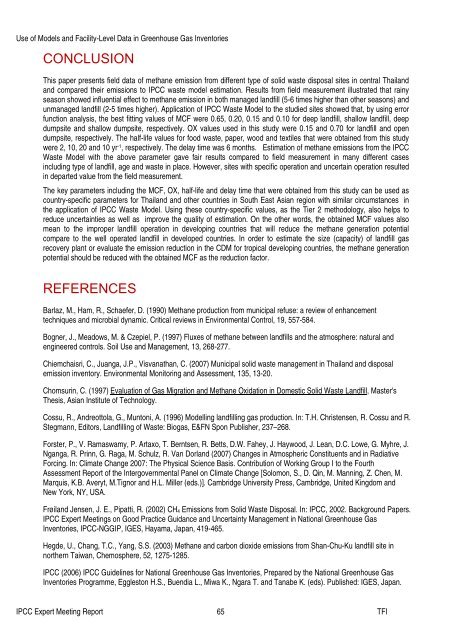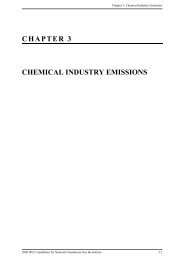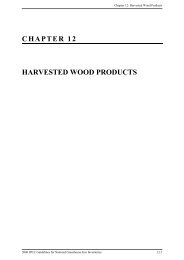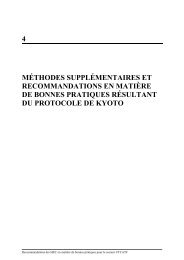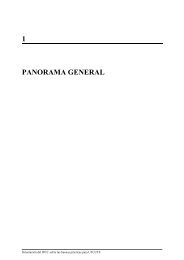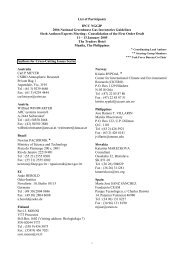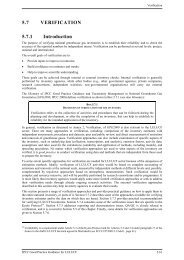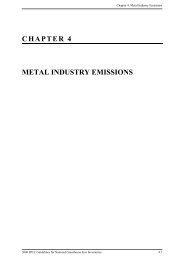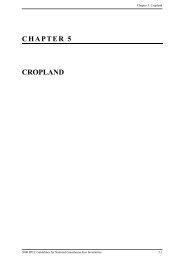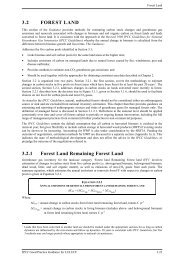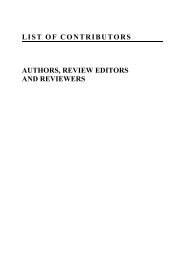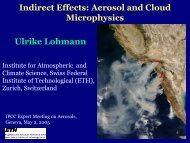Use of Models and Facility-Level Data in Greenhouse Gas Inventories
Use of Models and Facility-Level Data in Greenhouse Gas Inventories
Use of Models and Facility-Level Data in Greenhouse Gas Inventories
Create successful ePaper yourself
Turn your PDF publications into a flip-book with our unique Google optimized e-Paper software.
<strong>Use</strong> <strong>of</strong> <strong>Models</strong> <strong>and</strong> <strong>Facility</strong>-<strong>Level</strong> <strong>Data</strong> <strong>in</strong> <strong>Greenhouse</strong> <strong>Gas</strong> <strong>Inventories</strong><br />
CONCLUSION<br />
This paper presents field data <strong>of</strong> methane emission from different type <strong>of</strong> solid waste disposal sites <strong>in</strong> central Thail<strong>and</strong><br />
<strong>and</strong> compared their emissions to IPCC waste model estimation. Results from field measurement illustrated that ra<strong>in</strong>y<br />
season showed <strong>in</strong>fluential effect to methane emission <strong>in</strong> both managed l<strong>and</strong>fill (5-6 times higher than other seasons) <strong>and</strong><br />
unmanaged l<strong>and</strong>fill (2-5 times higher). Application <strong>of</strong> IPCC Waste Model to the studied sites showed that, by us<strong>in</strong>g error<br />
function analysis, the best fitt<strong>in</strong>g values <strong>of</strong> MCF were 0.65, 0.20, 0.15 <strong>and</strong> 0.10 for deep l<strong>and</strong>fill, shallow l<strong>and</strong>fill, deep<br />
dumpsite <strong>and</strong> shallow dumpsite, respectively. OX values used <strong>in</strong> this study were 0.15 <strong>and</strong> 0.70 for l<strong>and</strong>fill <strong>and</strong> open<br />
dumpsite, respectively. The half-life values for food waste, paper, wood <strong>and</strong> textiles that were obta<strong>in</strong>ed from this study<br />
were 2, 10, 20 <strong>and</strong> 10 yr -1 , respectively. The delay time was 6 months. Estimation <strong>of</strong> methane emissions from the IPCC<br />
Waste Model with the above parameter gave fair results compared to field measurement <strong>in</strong> many different cases<br />
<strong>in</strong>clud<strong>in</strong>g type <strong>of</strong> l<strong>and</strong>fill, age <strong>and</strong> waste <strong>in</strong> place. However, sites with specific operation <strong>and</strong> uncerta<strong>in</strong> operation resulted<br />
<strong>in</strong> departed value from the field measurement.<br />
The key parameters <strong>in</strong>clud<strong>in</strong>g the MCF, OX, half-life <strong>and</strong> delay time that were obta<strong>in</strong>ed from this study can be used as<br />
country-specific parameters for Thail<strong>and</strong> <strong>and</strong> other countries <strong>in</strong> South East Asian region with similar circumstances <strong>in</strong><br />
the application <strong>of</strong> IPCC Waste Model. Us<strong>in</strong>g these country-specific values, as the Tier 2 methodology, also helps to<br />
reduce uncerta<strong>in</strong>ties as well as improve the quality <strong>of</strong> estimation. On the other words, the obta<strong>in</strong>ed MCF values also<br />
mean to the improper l<strong>and</strong>fill operation <strong>in</strong> develop<strong>in</strong>g countries that will reduce the methane generation potential<br />
compare to the well operated l<strong>and</strong>fill <strong>in</strong> developed countries. In order to estimate the size (capacity) <strong>of</strong> l<strong>and</strong>fill gas<br />
recovery plant or evaluate the emission reduction <strong>in</strong> the CDM for tropical develop<strong>in</strong>g countries, the methane generation<br />
potential should be reduced with the obta<strong>in</strong>ed MCF as the reduction factor.<br />
REFERENCES<br />
Barlaz, M., Ham, R., Schaefer, D. (1990) Methane production from municipal refuse: a review <strong>of</strong> enhancement<br />
techniques <strong>and</strong> microbial dynamic. Critical reviews <strong>in</strong> Environmental Control, 19, 557-584.<br />
Bogner, J., Meadows, M. & Czepiel, P. (1997) Fluxes <strong>of</strong> methane between l<strong>and</strong>fills <strong>and</strong> the atmosphere: natural <strong>and</strong><br />
eng<strong>in</strong>eered controls. Soil <strong>Use</strong> <strong>and</strong> Management, 13, 268-277.<br />
Chiemchaisri, C., Juanga, J.P., Visvanathan, C. (2007) Municipal solid waste management <strong>in</strong> Thail<strong>and</strong> <strong>and</strong> disposal<br />
emission <strong>in</strong>ventory. Environmental Monitor<strong>in</strong>g <strong>and</strong> Assessment, 135, 13-20.<br />
Chomsur<strong>in</strong>, C. (1997) Evaluation <strong>of</strong> <strong>Gas</strong> Migration <strong>and</strong> Methane Oxidation <strong>in</strong> Domestic Solid Waste L<strong>and</strong>fill, Master's<br />
Thesis, Asian Institute <strong>of</strong> Technology.<br />
Cossu, R., Andreottola, G., Muntoni, A. (1996) Modell<strong>in</strong>g l<strong>and</strong>fill<strong>in</strong>g gas production. In: T.H. Christensen, R. Cossu <strong>and</strong> R.<br />
Stegmann, Editors, L<strong>and</strong>fill<strong>in</strong>g <strong>of</strong> Waste: Biogas, E&FN Spon Publisher, 237–268.<br />
Forster, P., V. Ramaswamy, P. Artaxo, T. Berntsen, R. Betts, D.W. Fahey, J. Haywood, J. Lean, D.C. Lowe, G. Myhre, J.<br />
Nganga, R. Pr<strong>in</strong>n, G. Raga, M. Schulz, R. Van Dorl<strong>and</strong> (2007) Changes <strong>in</strong> Atmospheric Constituents <strong>and</strong> <strong>in</strong> Radiative<br />
Forc<strong>in</strong>g. In: Climate Change 2007: The Physical Science Basis. Contribution <strong>of</strong> Work<strong>in</strong>g Group I to the Fourth<br />
Assessment Report <strong>of</strong> the Intergovernmental Panel on Climate Change [Solomon, S., D. Q<strong>in</strong>, M. Mann<strong>in</strong>g, Z. Chen, M.<br />
Marquis, K.B. Averyt, M.Tignor <strong>and</strong> H.L. Miller (eds.)]. Cambridge University Press, Cambridge, United K<strong>in</strong>gdom <strong>and</strong><br />
New York, NY, USA.<br />
Frøil<strong>and</strong> Jensen, J. E., Pipatti, R. (2002) CH 4 Emissions from Solid Waste Disposal. In: IPCC, 2002. Background Papers.<br />
IPCC Expert Meet<strong>in</strong>gs on Good Practice Guidance <strong>and</strong> Uncerta<strong>in</strong>ty Management <strong>in</strong> National <strong>Greenhouse</strong> <strong>Gas</strong><br />
<strong>Inventories</strong>, IPCC-NGGIP, IGES, Hayama, Japan, 419-465.<br />
Hegde, U., Chang, T.C., Yang, S.S. (2003) Methane <strong>and</strong> carbon dioxide emissions from Shan-Chu-Ku l<strong>and</strong>fill site <strong>in</strong><br />
northern Taiwan, Chemosphere, 52, 1275-1285.<br />
IPCC (2006) IPCC Guidel<strong>in</strong>es for National <strong>Greenhouse</strong> <strong>Gas</strong> <strong>Inventories</strong>, Prepared by the National <strong>Greenhouse</strong> <strong>Gas</strong><br />
<strong>Inventories</strong> Programme, Eggleston H.S., Buendia L., Miwa K., Ngara T. <strong>and</strong> Tanabe K. (eds). Published: IGES, Japan.<br />
IPCC Expert Meet<strong>in</strong>g Report 65 TFI


